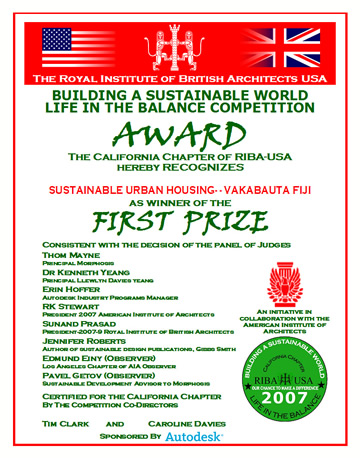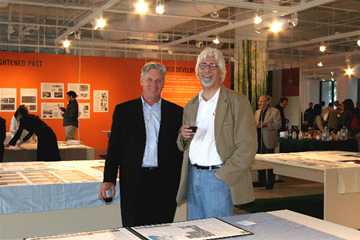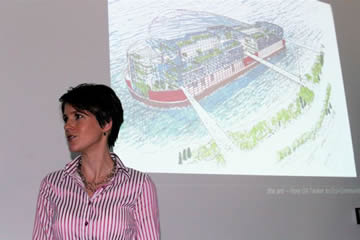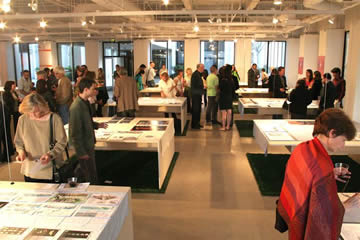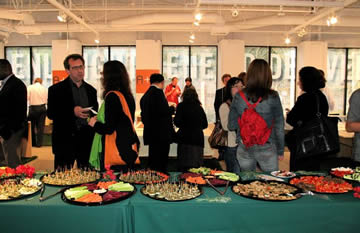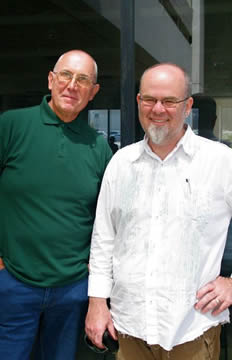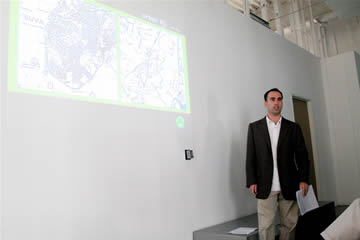FROM FIJI TO PHILADELPHIA: VISIONARY DESIGN TEAMS TAKE TOP HONORS IN INTERNATIONAL SUSTAINABLE DESIGN COMPETITION
Multidisciplinary Teams Tackle Climate Change with Innovative Plans for Healthy, Sustainable Communities
Los Angeles — June 12, 2007 — an Exhibition of 51 Entries – each a model response to the problem of Climate Change opened on Jjune 8th 2007 at the Architecture and Design Museam on Museum Row, Wilshire Blvd Los Angeles. At a symposium that followed at the A+D Museum June 8 through 10, four winning teams were selected from among twelve finalists who presented proposals as part of the Royal Institute of British Architects (RIBA)–USA California chapter’s competition, Building A Sustainable World: Life in the Balance. The competition, sponsored by Autodesk, Inc. attracted more than 50 entries from around the world. It challenged participants to develop concepts for healthy, vibrant communities designed to address climate change and reverse, rather than add to, environmental damage.
First Prize for $10,000 was awarded to a team from Fiji, Toby Kyle, Chris Cole and Kamineli Vuadreu. Toby Kyle and Chris Cole presented their project, Sustainable Urban Housing in Fiji – Vakabauta Village, which focuses on the needs of low-income Fijians living in dilapidated temporary housing in Suva, the country’s capital. The design concept addresses global problems with local solutions, including growing bamboo within the village to green and rejuvenate the site and create revenue opportunities for residents. The team drew on traditional Fijian values such as working together and sharing resources, to create a model sustainable urban community relevant not only to Fiji but to many developing Pacific nations that are likely to be particularly hard hit by the effects of climate change.
Second Prize for $5,000 went to an Australian team, Gall & Medek Architects/ and Team D/E/S of Brisbane. Jim Gall and Tony Fry presented the Boonah Two Development, a proposal that focuses on climate-adaptive strategies, technological innovation, and socio-cultural change projected over a 50-year period for the city of Boonah, about 100 km inland from the east coast of Australia. Although the Boonah Two Development proposal targets a particular city, the team’s design methodology is meant to be universally applicable. The design approach involves 10 key principles, including operating communities as closed-loop systems that produces no waste, creating foodscapes to reduce “food miles” and increase nutritional quality, and moving from reductionist linear thinking to relational thinking that aligns with ecological processes.
Third Prize for $2,500 went to The Urban Kidney — Revitalizing Forgotten Bottom, presented by Stephen Gibson from the United States design team of Wallace Roberts and Todd, LLC of Philadelphia. The team consisted of George Bryant, Stephen Gibson, Kyk Gradinger, John Keene, Adam Krom, Lauren Leatherbarrow, Jamie Ober, Anthony Okoye, yogesh Sooji, Ka Man Skinner, Devinder Soin. This proposal addresses the distressed, polluted Philadelphia neighborhood known as Forgotten Bottom, so called because residents feel the city has virtually forgotten that they exist. This multidisciplinary team developed a comprehensive plan for restoring a long-abused wetland as the centerpiece of a new neighborhood built on abandoned industrial brownfield. This project shows how the environmentally sensitive reclamation of post-industrial waterfronts can be used to meet other urban goals such as stormwater management, sustainable housing development and economic revitalization.
Bonus Prize for $5,000 was awarded to the entry that demonstrated the most imaginative use of Autodesk software, notably Architectural Desktop. This prize was awarded to Liu Di of China for his entry, Seasonal Flood Threatened Community. This entry proposed innovative architecture and engineering solutions designed to reduce the global warming impacts of buildings while also protecting communities from the ravages of major floods. The proposal, which focuses on a flood-prone community on the Changjiang River, includes a concept for zero net energy homes as well as safe temporary housing for those people made homeless by floods
Each entry tackled environmental and social challenges of enormous scope and offered engaging, inspiring solutions. In addition to the winning entries, the finalists included:
EcoSystemic Restoration: A Model Community at Salton Sea, a plan for healing the environment and living sustainably in this extremely hot, arid and ecologically scarred region of the southern California desert.
Presented by Ilaria Mazzoleni from italy; the team consisted of: Ilaria Mazzoleni, Philip Ra, Architect Yvonne Lau, Architect, Sky Milner, student in architecture, Harold Portillo, student in architecture, Amitabh Barthakur, urban planner, Vanessa Zajfen, agronomist - sustainable agriculture, Shauna Price, biologist, Sunil Varma, environmental engineer, Bungane Mehlomakulu, mechanical engineer; Sareen Proudian, student of architecture.
Adaptation to Climatic Disaster, innovative physical and cultural survival strategies for the Republic of Maldives, a nation whose highest elevation is 2.4 meters above sea level.
Presented by Junya Oishi from Costa Rca and Doris Sung from ScuiArch Los Angeles; the team consisted of: Junya Oishi and Doris Sung
Urban Model for Coal Country, a vision for transforming Appalachian hilltops decimated by coal mining into vibrant, pedestrian-friendly hill towns - taking advantage of an already scarred landscape which can be used for building, and reducing infrngement upon needed forest for settlement. Presented by Richard Levine from the Center for Sustainable Cities Design Studio, Kentucky State University; the team consisted of Richard S Levine (Architect), Michael T Hughes, Casey Ryan Mather, Taqi Radmard, Bill Fleming
Wall City, addressing rising waters in the Netherlands port city of Rotterdam with a proposal for a compact community based on a huge vertical walls that contain the city’s infrastructure. Presented by Vasilieos Kouisos from Greece, the project author
Suburban Renewal/Green Sacramento, a proposal to reclaim and reuse an abandoned strip mall and transform suburbs into dense, carbon-neutral communities for living, working, raising food, replenishing groundwater and rebuilding local ecologies. Presented by Geoffrey Holton from Oakland California, the team consisted of Geoffrey Holton Associates,
Algae City, responding to the challenges of energy consumption and urban sprawl with a concept to establish cities on modular platforms suspended above the ground and powered by clean hydrogen energy produced from algae. Presented by Marcelo Morettin from Brazil; The team consisted of Vinicius Hernandes Andrade/ Marcello Henneberg Morettin
Redeveloping the Ninth Ward, addressing environmentally and socially responsible community rebuilding designed to bring back local residents displaced by the Hurricane Katrina disaster. Presented by John Manaves from Chicago; The team consisted of John Manaves and his German partner Alice Kriegel
LIST OF AWARD WINNERS AND FINALISTS
FIRST PRIZE
Fiji: Toby Kyle, Chris Cole and Kamineli Vuadreu. Project: Sustainable Urban Housing in Fiji.
SECOND PRIZE
Australia: Gall and Medek Architects and Team DES. Project: Boonah Two Development.
THIRD PRIZE
United States: Wallace Roberts Todd, LLC (George B. Bryant, Stephen M. Gibson, Kyle Gradinger, John Keene, Adam Krom, Lauren W. Leatherbarrow, Jamie R. Ober, Anthony C. Okoye, Yogesh Saoji, KaMan E. Skinner, Devinder S. Soin, and Michael J. Tweed Jr.). Project: Urban Kidney Project — Revitalizing Forgotten Bottom.
HONORABLE MENTION
United Kingdom: Phil Garlick and Sustainable Construction Team. Project: Tankers Converted to Village.
SPECIAL AUTODESK PRIZE
China: Liu Di. Project: Seasonal Flood Threatened Community.
FINALISTS
Brazil: Vinicius Hernandes Andrade and Marcello Henneberg Morettin of Andrade Morettin Associates. Project: Algae City.
Greece: Vasileios Kiousis and Konstantinos Dimas. Project: Wall City, Rotterdam, Netherlands.
United States: John Manaves and Alice Kriegel. Project: Redeveloping the Ninth Ward.
United States: Ilaria Mazzoleni, Yvonne Lau, Philip Ra, Sareen Proudian, Sky Milner, Harold Portillo, Amitabh Barthakur, Vanessa Zajfen, Shauna Price, Sunil Varma, Bungane Mehlomakulu. Project: Ecosystem Restoration: A Model Community at Salton Sea.
United States: Geoffrey Holton and Associates (Geoffrey Holton, Gretchen Bigsby, David Waldorf, Gavin Ross). Project: Suburban Renewal/Green Sacramento.
United States: Center for Sustainable Cities Design Studio (Richard S. Levine, Michael T. Hughes, Casey Ryan Mather). Project: Urban Model for Coal Country.
United States: Junya Oishi. Project: Adaptation to Climatic Disaster.
SPONSOR
Autodesk, Inc.
COMPETITION PUBLISHER
Gibbs Smith, Publisher
ADDITONAL SPONSORS
The symposium weekend was hosted by the Architecture + Design Museum in Los Angeles, with a reception sponsored by Delta Faucet.
JUDGES
Sunand Prasad — President 2007–2009 of The Royal Institute of British Architects (RIBA). Principal, Penoyre-Prasad, London.
RK Stewart — President of The American Institute of Architects (AIA). Principal, Gensler, San Francisco.
Prof. Thom Mayne — Pritzker Prize Laureate, 2005. Principal, Morphosis, Los Angeles.
Dr. Ken Yeang — author, Ecodesign Instruction Manual. Principal, Llewelyn, Davies, Yeang.
Jennifer Roberts — author, Good Green Homes, Good Green Kitchens, and Redux: Designs That Reuse, Recycle, and Reveal (Gibbs Smith, Publisher).
Erin Rae Hoffer — AIA, Industry Programs Manager, AEC Solutions, Autodesk, Inc.
Pavel Getov — Observer. Sustainable Development Advisor to Morphosis.
Edmund Einy — Observer. Los Angeles Chapter of the AIA.
ADVISORY COUNCIL
Christopher Robbins — CEO and General Manager, Gibbs Smith Publisher.
Phil Bernstein — FAIA, RIBA. VP Industry Strategy and Relations, AEC Solutions, Autodesk, Inc.
Tracey Stout — Vice President, Autodesk, Inc.
Charles Qin — China National Enterprises Association for Foreign Trade and Economic Cooperation, The Ministry of Commerce, P.R. China.
Julia Russell — Eco-Home, Los Angeles.
The Board of Directors of RIBA-USA, California Chapter.
U.K. Consulate and California State Contacts
David Wild — Deputy Consul General at the UK Consulate General, Los Angeles.
Jennifer Gardner — MBE. UK Consulate General, Los Angeles.
BreAnda Northcutt — Representing the California Governor’s Office.
COMPETITION BACKGROUND
The Building A Sustainable World: Life in the Balance competition was announced June 2006, with a February 2007 deadline for receipt of the entries. Sixty-five submissions were registered, which encompassed over 200 people working individually or in teams. These included architects, city planners, engineers, students and designers from 18 countries: Australia, Belgium, Brazil, Canada, China, China–Hong Kong, Fiji, France, Germany, Greece, India, Iran, Ireland, Italy, Japan, Spain, Thailand, U.K., and U.S.A.
Building a Sustainable World: Life in the Balance was an open competition to develop concepts for a maximum-capacity sustainable community or an urban subdivision to address shifts in global climate, that have been so vividly demonstrated by increasing numbers of flooding and drought catastrophes. The community must be “off the grid”, in other words as autonomous and self-sustaining as possible. And, beyond this, participants were invited to propose ways of making the community a positive contributor to the natural ecology. Alternative energy solutions needed to be fully researched and integrated to identify advantages and to be realistic about risks and disadvantages. The competition premise is that the sustainable community should start to reverse environmental damage and not add to it. The community can include new industries, which must be clean and considerate to the quality of life for future generations. We want to create healthy, vibrant, non-toxic communities with a positive relationship, respect and regard for nature and our natural resources.
Eligibility: The competition was open to any individual from any country. However, an entrant who is not an architect had to team up with an accredited (licensed or registered) architect from the locality of the submitted project. Participants were encouraged to engage in teamwork with and between architects whether the entrant is a member of the general public, a writer, visionary, movie maker, engineer, city planner, designer or from the construction industry at large.
WEBSITE: http://www.riba-usa.org
Contact: Caroline Davies: photoartist@earthlink.net
Ph: (213) 399-1132
General Secretary, California Chapter Board of Directors
Tim Clark e: tc@anet.net
Ph: (213) 880-3309
RIBA-USA California Chatper Board of Directors
Founding President RIBA-USA and Past Presiding Chair
Representation for China and Asia:
Contact: Charles Qin and Angyla Wang
China National Enterprises
Association for Foreign Trade and Economic Cooperation
The Ministry of Commerce, P.R. China Zip Code: 100022
Tel: 8610-88792-441 Mobile: 139 1126 4785
Photographs by Caroline Davies
